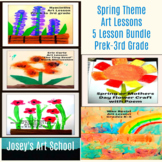Hyacinths Art Lesson Discussion and Writing Activity
The Gifted Learner
1.6k Followers
Grade Levels
PreK - 3rd
Subjects
Standards
CCSSK.MD.A.2
CCSS2.MD.A.1
CCSSK.G.A.2
CCSSK.G.B.4
CCSS1.G.A.1
Formats Included
- PDF
Pages
17 pages
The Gifted Learner
1.6k Followers
Also included in
- Spring is the theme of this art lesson bundle. I have lessons and projects with the Spring theme and each one has a DIFFERENT BIT OF INFORMATION TO SHARE AND PROJECT THAT ACCOMPANIES IT.Lessons include:HyacinthsEric CarleGeorgia O'KeefeOriental poppiesRainbow and ShowersWelcome to my series of crPrice $9.50Original Price $14.00Save $4.50
Description
This lesson is about Hyacinths. This lesson is perfect for Pre-k, Kindergarten, 1st and 2nd grade. This lesson is perfect as a sub plan or a fun filler lesson. Inside you will find a brief history about the flower and an easy step by step lesson plan for you to follow. I have also included a writing activity and a coloring page.
What teachers are saying:
- Great resource! Thank you!
- We used this for open house and it was a big hit.
- Wonderful fun art project
Make sure to click the GREEN STAR near my store name so that you can stay in touch with my store. I create new lessons every week.
Total Pages
17 pages
Answer Key
N/A
Teaching Duration
30 minutes
Report this resource to TPT
Reported resources will be reviewed by our team. Report this resource to let us know if this resource violates TPT’s content guidelines.
Standards
to see state-specific standards (only available in the US).
CCSSK.MD.A.2
Directly compare two objects with a measurable attribute in common, to see which object has “more of”/“less of” the attribute, and describe the difference. For example, directly compare the heights of two children and describe one child as taller/shorter.
CCSS2.MD.A.1
Measure the length of an object by selecting and using appropriate tools such as rulers, yardsticks, meter sticks, and measuring tapes.
CCSSK.G.A.2
Correctly name shapes regardless of their orientations or overall size.
CCSSK.G.B.4
Analyze and compare two- and three-dimensional shapes, in different sizes and orientations, using informal language to describe their similarities, differences, parts (e.g., number of sides and vertices/“corners”) and other attributes (e.g., having sides of equal length).
CCSS1.G.A.1
Distinguish between defining attributes (e.g., triangles are closed and three-sided) versus non-defining attributes (e.g., color, orientation, overall size); build and draw shapes to possess defining attributes.



